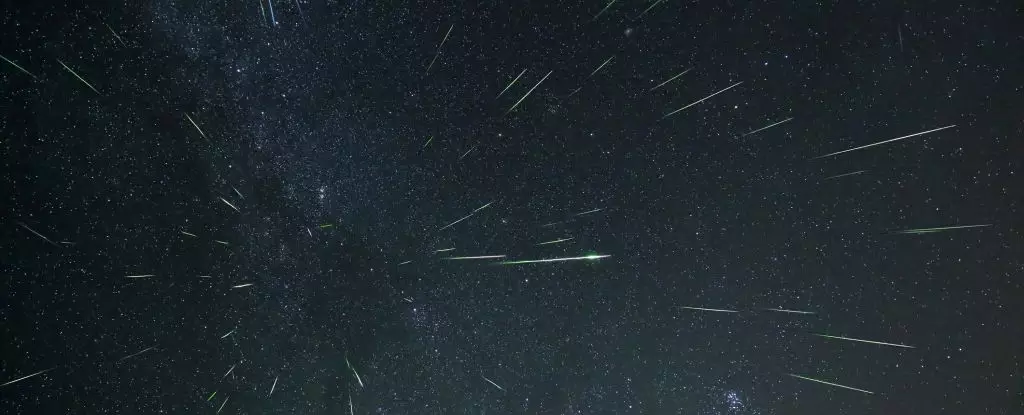As we transition into the heart of spring, the universe prepares to unveil two stunning displays that could capture the imagination of anyone with even the slightest inclination toward celestial wonders. The upcoming Lyrid and Eta Aquariid meteor showers promise to illuminate our nights with breathtaking streaks of light, serving as a reminder of our connection to the cosmos. While most of us are tethered to our daily routines, these meteor showers are the perfect invitation to step outside, glance upward, and appreciate the ephemeral beauty of the universe.
The Lyrid Meteor Shower: Nature’s Intriguing Performance
Scheduled to grace the skies starting on April 17 and running until April 26, the Lyrid meteor shower is poised to peak around the nights of April 21 and 22. What makes this meteor shower particularly enthralling is its historic connection to Comet C/1861 G1 (Thatcher), which completes its orbit around the Sun approximately every 422 years. The radiant point for the Lyrids lies near the constellation Lyra, creating a mesmerizing display that speaks to the very heart of astronomy.
Stargazers can expect to see around 10 to 15 meteors per hour under optimal conditions, meaning a clear, moonless night. This year’s circumstances will align with a waning moon, roughly 40 percent illuminated, which, while providing a gentle glow, may slightly diminish the visibility of the meteors. Nevertheless, the thrill of standing under the starry dome, awaiting nature’s fireworks, cannot be overstated. According to EarthSky, the ideal viewing time will be the evening of April 21, prior to moonrise, presenting an excellent opportunity for dedicated observers.
Migration of the Meteor: The Eta Aquariids Shine Bright
As we move into the latter half of April and approach May, the cosmic excitement only amps up with the Eta Aquariids meteor shower. This event, occurring from April 20 through May 21, peaks around May 2 and 3. Originating from the remnants of Halley’s Comet (1P/Halley)—a storied celestial traveler that makes a rendezvous with Earth every 76 years—the Eta Aquariids is set to dazzle viewers, particularly in the southern tropical regions.
With estimates of up to 50 to 60 meteors per hour in ideal conditions, the Eta Aquariids offers a significantly richer spectacle compared to its predecessor. The radiant point for this shower is located near the constellation Aquarius, and while observers in the northern hemisphere may enjoy a limited display, they can anticipate witnessing roughly 20 meteors per hour. It’s fascinating to consider that while we gaze upward, the same trails of cosmic debris have been part of a journey through the solar system that predates human existence.
Preparing for Celestial Observation
With two meteor showers right around the corner, the excitement of preparing for such events is palpable. The beauty of watching meteor showers is that virtually anyone can participate, requiring no specialized equipment—just a cozy spot with a clear view of the sky and a sense of wonder. Ideal viewing conditions often involve escaping urban light pollution and finding higher altitudes, where the celestial view is less obstructed.
While many might see meteor showers as fleeting moments of beauty, they actually serve as fascinating demonstrations of the mechanics of our solar system. Each tiny speck of dust traveling at immense speeds collides with our atmosphere, igniting in a spectacle of light that momentarily encapsulates our gaze. The thought that we are viewers of a process that has been happening for millennia imbues the experience with profound significance.
A Call to Action: Go Outside!
As the Lyrid and Eta Aquariid meteor showers approach, the urge to step outside and lose oneself in the night sky intensifies. It is an opportunity to reconnect with nature and the universe, moments to relish with family, friends, or even solo. The intricate dance of the universe and the fleeting beauty of the meteor showers underscore the importance of slowing down and appreciating the world we inhabit—a world that is part of a much larger cosmic scene.
Whether you’re an avid astronomer or a casual observer, make it a priority to witness these mesmerizing displays. This season holds the promise of celestial joy, allowing us to dream and gaze upward, reminding us of the elegant dance that binds our planet to the cosmos. So, grab a blanket, find a suitable spot, and prepare to be inspired by the stunning wonders that await in the heavens.


Leave a Reply